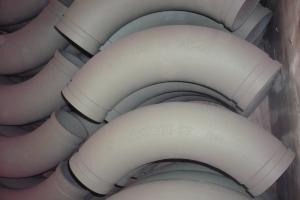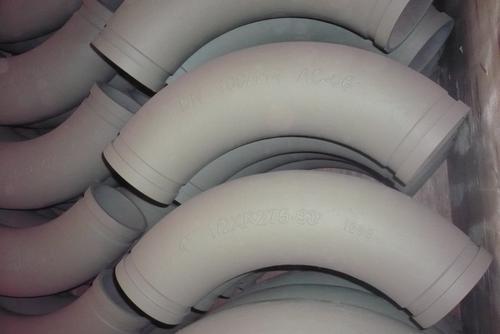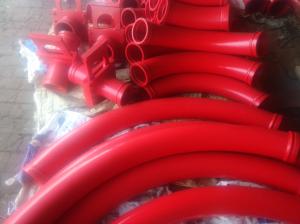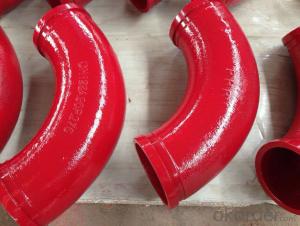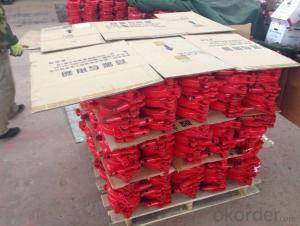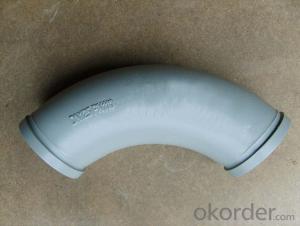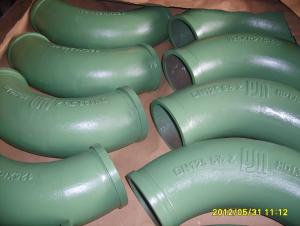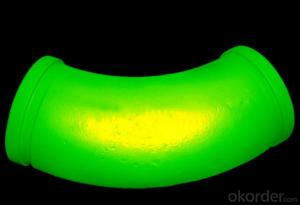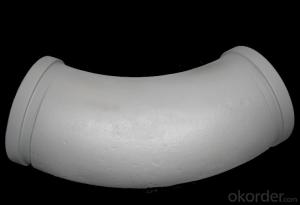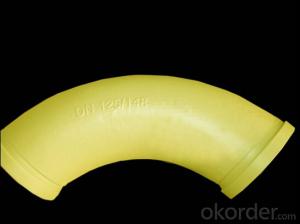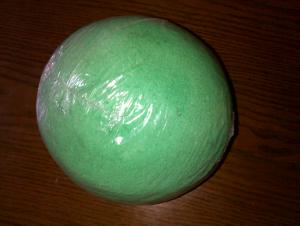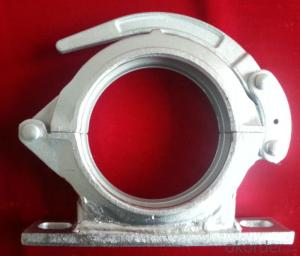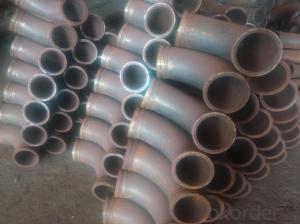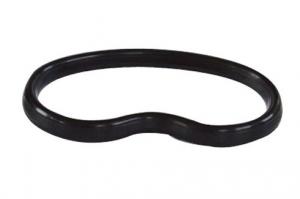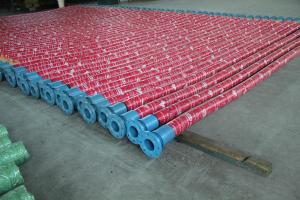Concrete Pump ELBOW R275, DGR 90 DN100 with High Quality
- Loading Port:
- Tianjin
- Payment Terms:
- TT or LC
- Min Order Qty:
- 5 pc
- Supply Capability:
- 10000 pc/month
OKorder Service Pledge
OKorder Financial Service
You Might Also Like
Product Description:
Product Name: Concrete Pump ELBOW R275, DGR 90 DN100
1. Specification
Dimensions: DN100MM
Radius: 275mm,1000mm
Flange: SK, ZX, F&M
Degree: 30°, 45°, 90°
Material: #20 steel, ST52, Mn 13-4
Thickness: 4.5mm,6mm,7.1mm,7.5mm,10mm,
Working pressure: 180MPa
Notes: total series of concrete pump clamp for different brand concrete pump(PUTZMEISTER, SCHWING, CIFA, SANY, ZOOMLION, IHI, KYOKUTO Etc) available from us.
2. Application of Concrete Pump Bend DN125
Concrete Pump ELBOW R275, DGR 90 DN100widely used on concrete pump truck, concrete placing boom, trailer concrete pump etc, for concrete delivery pipe connection.
Our concrete pump bends have been successfully exported to many countries from 1998, Our main markets as below: Middle East, Southeast Asia, America, Brazil, Italy, Russia, South Africa etc
Aiming at the largest concrete pump parts manufacturer, and reliable, professional supplier in China, we can supply concrete pump elbows, delivery pipes, casting or forging couplings, end rubber hoses, rubber pistons, tungsten wear plates, delivery cylinders, and other hydraulic parts, one stop service for your concrete pump parts and accessory business.
3. Package and Delivery of Concrete Pump Bends
Every 60pcs Concrete Pump Bend DN125 put in one seaworthy wooden box, and 20 boxes in one 20feet container.
FAQ:
Q1: Why buy Materials & Equipment from OKorder.com?
A1: All products have its ISO certifications, adheres to the highest standards and a commitment to supply chain safety and customer satisfaction.
Q2: How do we guarantee the quality of our products?
A2: We have established an advanced quality management system which conducts strict quality tests at every step, from raw materials to the final product. At the same time, we provide extensive follow-up service assurances as required.
Q3: How soon can we receive the product after purchase?
A3: Within three days of placing an order, we will begin production. The specific shipping date is dependent upon international and government factors, but is typically 10 to 30 workdays.
Q4: If we can produce some Concrete Pump ELBOW R275, DGR 90 DN100 according to customers request?
A4: Yes, we can produce Concrete Pump ELBOW R275, DGR 90 DN100 according to the difference country situations and different concrete pump to make it suitable to the market and customers. We have very professional technical team to make the design.
Q5: How to make a quick resolution for after service?
A5:We have overseas branches all-around of world, IF needed, the seller shall dispatch 2 engineers to the buyer's site for supervision of training. The buyer shall make available of necessary facilities &skilled personnel at site for training.
Images:
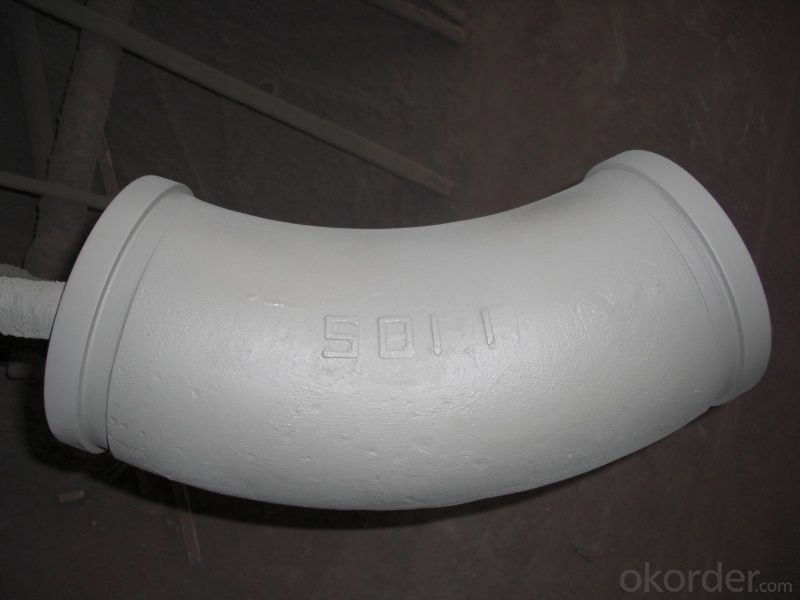
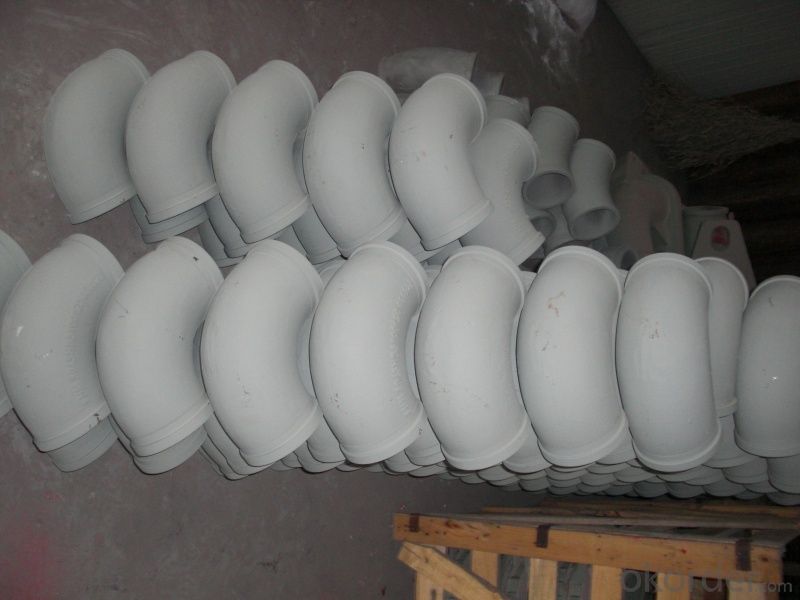
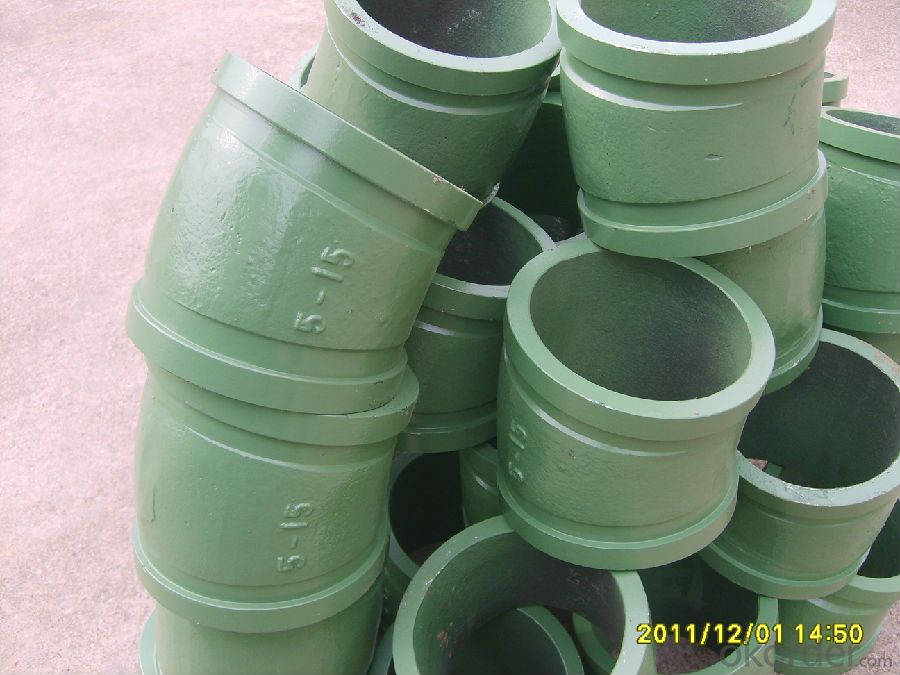
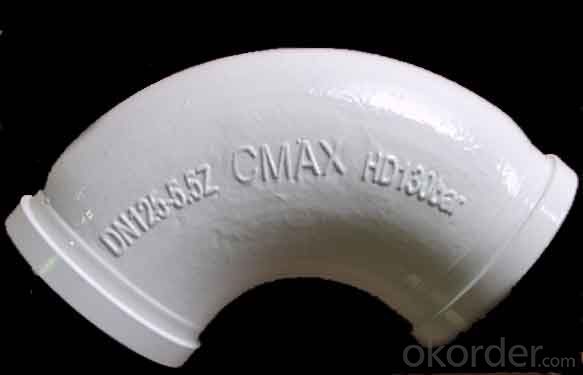
- Q: What are the signs of a malfunctioning hydraulic oil cooler?
- There are various indications that may suggest a malfunctioning hydraulic oil cooler. 1. Overheating: The engine or hydraulic system experiencing overheating is one of the most common indications. If the hydraulic oil cooler is not functioning correctly, it may fail to adequately cool down the hydraulic fluid, resulting in elevated temperatures in the system. This can result in decreased performance, increased component wear and tear, and potential fluid breakdown. 2. Fluid Leaks: Another indication is the presence of hydraulic fluid leaks. Damaged or worn seals, gaskets, or hoses in a malfunctioning hydraulic oil cooler can cause these leaks. The leaks can be observable as fluid drips or puddles beneath the machinery or as oily residue on components. 3. Increased Noise: A malfunctioning hydraulic oil cooler can also cause heightened noise levels in the hydraulic system. This could be attributed to the introduction of air into the system, leading to cavitation or aeration. These abnormal noises can signal that the cooler is not functioning correctly and should be inspected or replaced. 4. Elevated Temperatures: Consistently higher-than-normal readings on the temperature gauge of your hydraulic system could indicate a malfunctioning oil cooler. The cooler may be unable to effectively dissipate heat from the hydraulic fluid, resulting in rising temperatures. This can lead to reduced efficiency, increased component wear, and potential system failures. 5. Reduced Performance: A malfunctioning hydraulic oil cooler can also result in reduced overall machinery or equipment performance. This can manifest as slower operation, decreased power output, or diminished hydraulic system response. If you observe a decrease in performance, it is advisable to inspect the oil cooler for any issues. Promptly addressing any of these indications is crucial. Continuing to operate machinery with a malfunctioning hydraulic oil cooler can cause further damage, increased downtime, and potentially expensive repairs. It is recommended to consult with a qualified technician or hydraulic specialist to diagnose and resolve any problems with the oil cooler.
- Q: Are there any specific regulations or standards for the labeling and packaging of concrete pump spare parts?
- Concrete pump spare parts are subject to specific regulations and standards regarding their labeling and packaging. These regulations and standards aim to guarantee safety, proper handling, and ease of identification for these spare parts. A key regulation requires clear and legible labeling on the packaging of concrete pump spare parts. This labeling must include essential information such as the manufacturer's name, part number, description, as well as any specific instructions or warnings for handling and installation. This ensures that users can easily identify the spare parts and comprehend their purpose and correct usage. Furthermore, specific standards may exist for the packaging material utilized for concrete pump spare parts. These standards may demand the use of durable and protective packaging materials to prevent damage during transportation and storage. By doing so, the quality and functionality of the spare parts are preserved until they are ready for use. Moreover, regulations may be in place regarding the labeling and packaging of spare parts concerning safety. For instance, certain spare parts may necessitate special labeling or packaging to indicate the presence of hazardous materials or potential risks if mishandled. This is crucial for ensuring the safety of those handling the spare parts and for compliance with relevant safety regulations. In conclusion, the labeling and packaging of concrete pump spare parts are governed by specific regulations and standards to ensure proper identification, handling, and safety. These regulations and standards play a vital role in upholding a high level of quality and reliability for these spare parts within the construction industry.
- Q: How to calculate the power of concrete pump motor?
- Of course, the motor power is large, the transmission speed is fast
- Q: Are there any specific troubleshooting steps for identifying issues with concrete pump spare parts?
- Concrete pump spare parts can be identified for issues by following specific troubleshooting steps. These steps include conducting a thorough visual inspection of the spare parts to look for signs of wear, damage, or misalignment. Cracks, breaks, or any visible signs of damage should be checked for. The functionality of the spare parts can be tested by operating the concrete pump and paying attention to abnormal noises, vibrations, or irregular movements. A pressure test can be performed by connecting a pressure gauge to the pump and checking if it reaches the desired pressure levels. Any abnormal pressure fluctuations can indicate issues. A flow test can be conducted to evaluate the flow rate of the concrete through the pump and check for any blockages or irregular flow patterns. The spare parts should be inspected for leaks or fluid seepage, which can indicate faulty seals, gaskets, or fittings. Technical manuals provided by the manufacturer can be consulted for troubleshooting guidelines specific to the concrete pump spare parts. If unable to identify the issue, it is advisable to seek expert advice from a qualified technician or the manufacturer's technical support team. By following these troubleshooting steps, it becomes easier to promptly identify and address any issues with concrete pump spare parts.
- Q: What is the purpose of a concrete pump hydraulic oil cooler?
- The purpose of a concrete pump hydraulic oil cooler is to regulate and maintain the temperature of the hydraulic oil used in the pump system. By cooling the oil, it helps prevent overheating and ensures optimal performance and longevity of the hydraulic components.
- Q: How often should hydraulic oil filters be replaced in a concrete pump?
- The replacement frequency of hydraulic oil filters in a concrete pump is determined by several factors, such as operating conditions, oil type, and manufacturer recommendations. It is generally advised to replace these filters every 500 to 1000 operating hours or every 6 to 12 months, depending on which comes first. However, it is crucial to refer to the concrete pump's operation manual or the manufacturer's guidelines to determine the exact replacement interval for the hydraulic oil filters. Monitoring the filter's condition regularly and conducting routine maintenance checks can also aid in identifying the need for an earlier filter replacement than the recommended interval.
- Q: How does the concrete pump work?
- Pump in place should be flat and solid, without obstacles around, no overhead transmission line. The pump shall not be parked on the slope.
- Q: How do I properly maintain and replace concrete delivery pipes in concrete pump spare parts?
- Properly maintaining and replacing concrete delivery pipes in concrete pump spare parts is crucial to ensure the efficient and safe operation of the concrete pump. Here are some steps you can follow: 1. Regular Inspection: Regularly inspect the concrete delivery pipes for any signs of wear and tear, cracks, or damage. Look for any leaks or blockages that may affect the concrete flow. Identify any weak points that may require replacement. 2. Cleaning: Clean the concrete delivery pipes thoroughly after each use. Use water and a high-pressure hose to remove any concrete residue or build-up. This will prevent clogging and maintain the smooth flow of concrete. 3. Lubrication: Apply a suitable lubricant to the inner surface of the pipes to reduce friction and prevent concrete from sticking. This will help prolong the life of the pipes and ensure smooth concrete flow. 4. Replace Worn-out Parts: Monitor the condition of the delivery pipes and replace any worn-out or damaged parts promptly. Over time, the pipes may become corroded or develop cracks, affecting their performance. Replace these parts with high-quality spare parts to ensure the best results. 5. Proper Handling: Handle the concrete delivery pipes with care to avoid any unnecessary damage. Avoid dropping or mishandling the pipes during transportation or storage. Protect them from extreme weather conditions and store them in a dry and secure place. 6. Training and Safety: Ensure that the personnel operating the concrete pump are well-trained in handling and maintaining the equipment. Educate them about the importance of regular inspections, cleaning, and replacement of parts. Emphasize safety protocols to prevent accidents and ensure the longevity of the concrete delivery pipes. By following these steps, you can properly maintain and replace concrete delivery pipes in concrete pump spare parts, ensuring the efficient and safe operation of your concrete pump. Regular maintenance and prompt replacement of worn-out parts will help extend the life of the pipes and ensure the smooth flow of concrete during construction projects.
- Q: Can concrete pump spare parts be customized with branding or logos?
- Yes, concrete pump spare parts can be customized with branding or logos. Many manufacturers and suppliers offer the option to personalize spare parts with branding or logos according to the customer's requirements. This customization helps in promoting the brand and creating a unique identity for the concrete pump spare parts.
- Q: How do I ensure the reliability of concrete pump spare parts in critical applications?
- To guarantee the dependability of concrete pump spare parts in crucial applications, there are various measures you can implement: 1. Select a reputable supplier: Carry out research and choose a trusted supplier renowned for supplying top-notch concrete pump spare parts. Look for suppliers with a solid track record, positive feedback from customers, and certifications that validate their commitment to quality and dependability. 2. Verify product specifications and certifications: Prior to purchasing any spare parts, carefully assess the product specifications and certifications. Ensure that the parts meet the required standards and have undergone thorough testing to ensure their reliability in crucial applications. 3. Perform regular maintenance and inspections: Establish a comprehensive maintenance and inspection schedule for your concrete pump and its spare parts. Regularly inspect for signs of wear, damage, or malfunction. Replace any parts that display signs of deterioration or no longer meet the required specifications. 4. Utilize authentic spare parts: Always opt for genuine spare parts specifically designed for your concrete pump model. Authentic parts are manufactured to the highest standards and are more likely to deliver reliable performance in crucial applications compared to generic or counterfeit alternatives. 5. Maintain an inventory of critical spare parts: Identify the most crucial spare parts that are susceptible to failure or wear and keep a stock of these parts readily available. This will minimize downtime in the event of unexpected failures and ensure the swift replacement of any faulty components. 6. Train and educate operators: Provide comprehensive training to your concrete pump operators on the proper handling and maintenance of spare parts. Educate them on the significance of adhering to manufacturer guidelines and best practices to maximize the reliability and longevity of the equipment. 7. Give priority to safety: Safety should always be a primary concern in crucial applications. Ensure that the spare parts you utilize comply with safety regulations and standards. Regularly evaluate and update safety protocols to minimize the risk of accidents or equipment failure. By following these measures, you can enhance the dependability of concrete pump spare parts in crucial applications, reducing the chances of downtime and ensuring the seamless operation of your equipment.
Send your message to us
Concrete Pump ELBOW R275, DGR 90 DN100 with High Quality
- Loading Port:
- Tianjin
- Payment Terms:
- TT or LC
- Min Order Qty:
- 5 pc
- Supply Capability:
- 10000 pc/month
OKorder Service Pledge
OKorder Financial Service
Similar products
Hot products
Hot Searches
Related keywords
